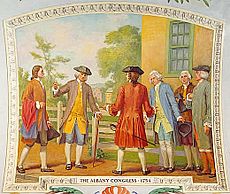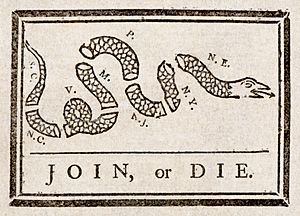Albany Congress facts for kids
Quick facts for kids Albany Congress |
|
|---|---|
| Part of the French and Indian War | |

The Albany Congress · 1754 by Allyn Cox
|
|
| Type | |
| Type | |
| History | |
| Founded | June 19, 1754 |
| Disbanded | July 11, 1754 |
| Succeeded by | Stamp Act Congress |
| Leadership | |
|
Governor
|
James DeLancey
|
| Seats | 21 |
| Meeting place | |
| City Hall (Dutch: Stadt Huys) Albany, New York |
|
The Albany Congress was an important meeting held from June 19 to July 11, 1754. It was also called the Albany Convention of 1754. Representatives from seven of the thirteen British colonies in British North America came together. These colonies were Connecticut, Maryland, Massachusetts, New Hampshire, New York, Pennsylvania, and Rhode Island.
The delegates met daily at the City Hall in Albany. Their main goals were to improve relationships with American Indian tribes. They also wanted to plan ways to defend themselves against the French threat from Canada. This meeting happened at the start of the French and Indian War. This war was part of a bigger conflict between Great Britain and France called the Seven Years' War.
The people at the Albany Congress did not plan to create a new American nation. Instead, they focused on making a treaty with the Mohawks and other major Iroquois tribes. This was the first time American colonists had met to discuss common issues. It later served as a model for other important meetings. These included the Stamp Act Congress in 1765 and the First Continental Congress in 1774. These meetings eventually led to the American Revolution.
Contents
Why the Albany Congress Was Important
The Albany Congress was the first time in the 1700s that American colonial representatives met to talk about forming a formal union. Before this, in the 1600s, some New England colonies had created a loose group called the New England Confederation. This group was mainly for defense because French and allied Indian tribes often raided their settlements.
Later, in the 1680s, the British government tried to unite the colonies. They created the Dominion of New England. This was a single government for colonies between the Delaware River and Penobscot Bay. However, it was dissolved in 1689. In 1690, Jacob Leisler called for a meeting of colonies in New York. He wanted to plan actions against the French and Indians. But only colonies as far south as Maryland joined him.
The Albany Plan of Union
The delegates at the Albany Congress spent most of their time discussing Benjamin Franklin's idea. This idea was called the Albany Plan of union. It aimed to create a unified government for the colonies. The delegates approved a plan that suggested uniting 11 colonies. This union would have a president chosen by the British King.
Each colonial assembly would send 2 to 7 delegates to a "grand council." This council would have the power to make laws. The new union would also be in charge of matters related to Indian affairs.
Why the Plan Was Rejected
The colonies' legislatures rejected the plan. They wanted to protect their own independent charters and powers. The British government also rejected it. They preferred to have military control over the colonies.
Even though it was rejected, many parts of the Albany Plan were later used. They became the basis for the American government set up by the Articles of Confederation in 1777. They also influenced the Constitution in 1787.
Benjamin Franklin thought about this in 1789. He believed that if the 1754 plan had been accepted, the colonies might not have separated from England so soon. He felt that if the colonies were united, they could have defended themselves. Then, Britain wouldn't have needed to send an army. This might have prevented the reasons for the Stamp Act and other taxes. These taxes caused the break between Britain and America.
The Albany Congress and its plan are seen as very important. They showed an early step towards the formation of the United States of America in 1776. Franklin's famous snake cartoon, Join, or Die, often illustrates this event.

Benjamin Franklin's plan to unite the colonies went beyond the original purpose of the congress. The congress was called to plan defense against the French and Indian threat. All who attended the meeting debated the original plan. This included a young lawyer from Philadelphia named Benjamin Chew. Thomas Hutchinson, who later became Governor of Massachusetts, also suggested many changes.
The delegates passed the plan without anyone voting against it. They sent it with their suggestions. However, the legislatures of the seven colonies rejected it. They felt it would take away some of their existing powers. The plan was never sent to the King for approval. It was sent to the British Board of Trade, which also rejected it.
What the Plan Proposed
The Plan of Union suggested including all the British North American colonies. However, no colonies south of Maryland sent representatives to the Albany Congress. (The "Lower Counties on the Delaware" were then managed by Pennsylvania, and the Georgia Colony was still developing.)
The plan called for a single leader called a President-General. The King would appoint this person. The President-General would be in charge of relations with the Indians. They would also handle military readiness and enforce laws about trade and money. The plan also suggested a Grand Council. Colonial legislatures would choose its members. The number of delegates would depend on how much tax each colony paid.
Even though the colonial assemblies rejected the plan, some of its ideas were used later. They were included in the Articles of Confederation and the Constitution after the American Revolution.
Who Participated in the Congress
Twenty-one representatives attended the Congress. They came from New York, Pennsylvania, Maryland, Massachusetts, Rhode Island, Connecticut, and New Hampshire. New York Governor James DeLancey was the host governor and the Chairman of the meeting. Peter Wraxall worked as the Secretary for the Congress.
Here are some of the delegates who attended:
- Connecticut: William Pitkin‡, Oliver Wolcott, Elisha Williams
- Maryland: Abraham Barnes, Benjamin Tasker Jr.‡
- Massachusetts: Thomas Hutchinson‡, Oliver Partridge
- New Hampshire: Meshech Weare, Theodore Atkinson‡
- New York: James DeLancey, William Johnson‡, Philip Livingston, William Smith‡
- Pennsylvania: Secretary Benjamin Chew, John Penn, Richard Peters, Isaac Norris, and Benjamin Franklin. Conrad Weiser and Benjamin Franklin's son William‡ attended as extra staff.
- Rhode Island: Martin Howard, Stephen Hopkins‡
‡ Indicates Members of the committee of the Plan of Union
See also
 In Spanish: Congreso de Albany para niños
In Spanish: Congreso de Albany para niños

